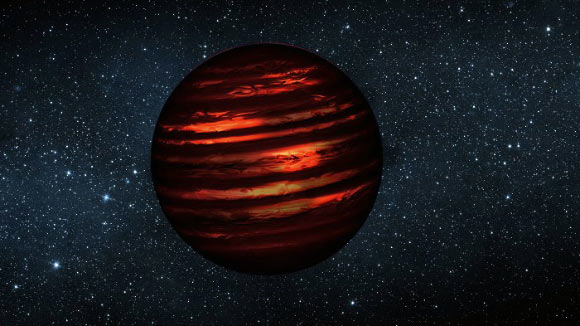A team of astronomers led by the Carnegie Institution has discovered that what scientists had previously thought was one of the closest brown dwarfs to the Solar System is in fact a giant planet.

An artist’s conception of SIMP0136, a planetary-like member of the 200-million-year-old Carina-Near group. Image credit: NASA / JPL / Jonathan Gagne.
The planetary object in question, called SIMP J013656.5+093347 (SIMP0136 for short), is located approximately 21 light-years away from Earth, in the constellation Pisces.
It was discovered in 2006 by University of Montréal astronomer Dr. Étienne Artigau and co-authors. The discovery was made as part of a near-infrared proper-motion survey, SIMP (Sondage Infrarouge de Mouvement Propre).
Dr. Artigau’s team has now determined that SIMP0136 is in fact a planetary member of a 200-million-year-old group of stars called Carina-Near.
“Groups of similarly aged stars moving together through space are considered prime regions to search for free-floating planetary like objects, because they provide the only means of age-dating these cold and isolated worlds,” the astronomers said.
“Knowing the age, as well as the temperature, of a free-floating object like this is necessary to determine its mass.”
The scientists were able to demonstrate that at about 13 times the mass of Jupiter, SIMP0136 is right at the boundary that separates brown dwarf-like properties, primarily the short-lived burning of deuterium in the object’s core, from planet-like properties.
“It used to be obvious that planets were distinct from stars. But SIMP0136 and others are ‘breaking’ these definitions,” said team member Prof. Adam Burgasser, from the University of California, San Diego.
Free-floating planetary mass objects are valuable because they are very similar to gas giant exoplanets that orbit around stars, like our own Solar System’s Jupiter or Saturn, but it is comparatively much easier to study their atmospheres.
Observing the atmospheres of exoplanets found within distant star systems is challenging, because dim light emitted by those orbiting exoplanets is overwhelmed by the brightness of their host stars, which blinds the instruments that astronomers use to characterize exoplanets’ atmospheres.
“The implication that the well-known SIMP0136 is actually more planet-like than we previously thought will help us to better understand the atmospheres of giant planets and how they evolve,” said team member Dr. Jonathan Gagné, from the Carnegie Institution.
“They may be easier to study in great detail, but these free-floating worlds are still extremely hard to discover unless scientists spend a lot of time observing them at the telescope, because they can be located anywhere in the sky and they are very hard to tell apart from brown dwarfs or very small stars.”
“This newest addition to the very select club of free-floating planetary like objects is particularly remarkable, because we had already detected fast-evolving weather patterns on the surface of SIMP0136, back when we thought it was a brown dwarf,” Dr. Artigau said.
“This discovery highlights how much there remains to be learned about the stars, brown dwarfs and exoplanets in the immediate vicinity of the Sun,” Prof. Burgasser said.
“To find that one of our nearest neighbors is at this fuzzy boundary between stars and planets suggests many more of these remarkable sources may be out there.”
The paper reporting this work has been accepted for publication in the Astrophysical Journal Letters and is available online at arXiv.org.
_____
Jonathan Gagné et al. 2017. SIMP J013656.5+093347 is Likely a Planetary-Mass Object in the Carina-Near Moving Group. ApJL, accepted for publication; arXiv: 1705.01625







